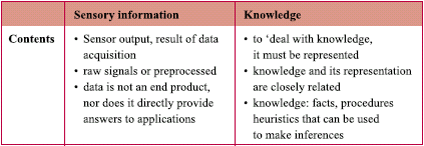| Navigation | |
The conceptual intelligent navigator
|
||||
|
The goal of developing any intelligent machine is to mimic human behaviors and achieve certain goals that can not be fulfi lled by adopting conventional methods [Cawsey, 1998]. According to Honavar and Uhr [1994], the intelligence can be defi ned as the ability to learn, understand and adapt. The human brain has the ability to learn adaptively in response to knowledge, experience and environments by a network of interconnected adaptive information processing elements that transform inputs to desired outputs [Principe et al, 2000]. In other words, the intelligence fi rst requires the ability to transform the acquired sensory information or raw data to certain form of useful information which can be regarded as knowledge. In addition, it demands a continuous learning process to guarantee the accumulation of acquired knowledge. Thus, the conceptual intelligent navigator is expected to have the ability to learn and adapt. Learning is defi ned as a process of acquiring and memorizing new information, knowledge and experience [Cawsey, 1998]. The adaptation can be regarded as the ability of the information processing elements to change in a systematic manner and alter the nonlinear transformation between inputs and outputs. In other words, learning and adaptation are interpreted as the mechanization of knowledge evolution process. Therefore, the intelligence of human is derived and accumulated through continuous sensory data acquisition and knowledge evolution. Table 2 illustrates the comparison between sensory information and knowledge. In addition, Figure (2) depicts the process of adopting acquired sensory information to generate certain knowledge through human vision. Being inspired by Figure (2) and Table 2, thus, three functional schemes of the knowledge evolution process of the conceptual intelligent navigator that fulfi ll the requirements of selflearning or adaptive learning can be identifi ed, as shown in Figure (3). As indicated in the Figure (3), to acquire the navigation knowledge for further processing, Chiang [2004] proposed several ANNs based INS/GPS integration schemes that use Multi-layered for further processing, Chiang [2004] proposed several ANNs based INS/GPS integration schemes that use Multi-layered Feed-forward Neural Networks (MFNNs). The MFNNs trained by the backpropagation algorithm is the most well-known and most common used neural network today. The INS/GPS integration architecture implemented in this article isalledthe Position Update Architecture (PUA) which consists of a two layered feed-forward neural network. It integrates the data from INS and DGPS and mimics the dynamical model of the vehicle to generate navigation knowledge. Thus the latest acquired navigation knowledge can The topology of PUA is illustrated on the left side of Figure (4). The input neurons receive the velocity at current epoch (VINS(t)), azimuth at urrent The desired outputs (dNGPS(t), dGPSE(t)) are provided by GPS during ignal availability in either DGPS or SPP mode of operation. As long as the GPS signals are available for more than 4 satellites, the learning process continues to reduce the estimation error in order to obtain optimal values of the NN parameters. Thus, the navigation knowledge can be learnt, stored and accumulated during the availability of the GPS signal. On the other hand, during GPS signal outages, the latest acquired navigation knowledge can be retrieved from the “brain” of As indicated in Figure (3), the second step towards building the conceptual intelligent navigator is to store the learnt knowledge acquired in the previous section. As a result, a navigation information database (NAVi) that contains the acquired and learnt navigation knowledge can serve as the “brain” of the conceptual intelligent navigator, as shown in the Figure (5). |
||||















 (No Ratings Yet)
(No Ratings Yet)





